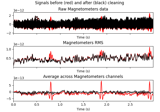mne.preprocessing.corrmap#
- mne.preprocessing.corrmap(icas, template, threshold='auto', label=None, ch_type='eeg', *, sensors=True, show_names=False, contours=6, outlines='head', sphere=None, image_interp='cubic', extrapolate='auto', border='mean', cmap=None, plot=True, show=True, verbose=None)[source]#
Find similar Independent Components across subjects by map similarity.
Corrmap 1 identifies the best group match to a supplied template. Typically, feed it a list of fitted ICAs and a template IC, for example, the blink for the first subject, to identify specific ICs across subjects.
The specific procedure consists of two iterations. In a first step, the maps best correlating with the template are identified. In the next step, the analysis is repeated with the mean of the maps identified in the first stage.
Run with
plotandshowset toTrueandlabel=Falseto find good parameters. Then, run with labelling enabled to apply the labelling in the IC objects. (Running with bothplotandlabelsoff does nothing.)Outputs a list of fitted ICAs with the indices of the marked ICs in a specified field.
The original Corrmap website: www.debener.de/corrmap/corrmapplugin1.html
- Parameters
- icas
listofmne.preprocessing.ICA A list of fitted ICA objects.
- template
tuple|np.ndarray, shape (n_components,) Either a tuple with two elements (int, int) representing the list indices of the set from which the template should be chosen, and the template. E.g., if template=(1, 0), the first IC of the 2nd ICA object is used. Or a numpy array whose size corresponds to each IC map from the supplied maps, in which case this map is chosen as the template.
- threshold“auto” |
listoffloat|float Correlation threshold for identifying ICs If “auto”, search for the best map by trying all correlations between 0.6 and 0.95. In the original proposal, lower values are considered, but this is not yet implemented. If list of floats, search for the best map in the specified range of correlation strengths. As correlation values, must be between 0 and 1 If float > 0, select ICs correlating better than this. If float > 1, use z-scoring to identify ICs within subjects (not in original Corrmap) Defaults to “auto”.
- label
None|str If not None, categorised ICs are stored in a dictionary
labels_under the given name. Preexisting entries will be appended to (excluding repeats), not overwritten. If None, a dry run is performed and the supplied ICs are not changed.- ch_type‘mag’ | ‘grad’ | ‘planar1’ | ‘planar2’ | ‘eeg’
The channel type to plot. Defaults to ‘eeg’.
- sensors
bool|str Whether to add markers for sensor locations. If
str, should be a valid matplotlib format string (e.g.,'r+'for red plusses, see the Notes section ofplot()). IfTrue(the default), black circles will be used.- show_names
bool|callable() If
True, show channel names next to each sensor marker. If callable, channel names will be formatted using the callable; e.g., to delete the prefix ‘MEG ‘ from all channel names, pass the functionlambda x: x.replace('MEG ', ''). Ifmaskis notNone, only non-masked sensor names will be shown.- contours
int| array_like The number of contour lines to draw. If
0, no contours will be drawn. If a positive integer, that number of contour levels are chosen using the matplotlib tick locator (may sometimes be inaccurate, use array for accuracy). If array-like, the array values are used as the contour levels. The values should be in µV for EEG, fT for magnetometers and fT/m for gradiometers. Ifcolorbar=True, the colorbar will have ticks corresponding to the contour levels. Default is6.- outlines‘head’ |
dict|None The outlines to be drawn. If ‘head’, the default head scheme will be drawn. If dict, each key refers to a tuple of x and y positions, the values in ‘mask_pos’ will serve as image mask. Alternatively, a matplotlib patch object can be passed for advanced masking options, either directly or as a function that returns patches (required for multi-axis plots). If None, nothing will be drawn. Defaults to ‘head’.
- sphere
float| array_like | instance ofConductorModel|None| ‘auto’ | ‘eeglab’ The sphere parameters to use for the head outline. Can be array-like of shape (4,) to give the X/Y/Z origin and radius in meters, or a single float to give just the radius (origin assumed 0, 0, 0). Can also be an instance of a spherical
ConductorModelto use the origin and radius from that object. If'auto'the sphere is fit to digitization points. If'eeglab'the head circle is defined by EEG electrodes'Fpz','Oz','T7', and'T8'(if'Fpz'is not present, it will be approximated from the coordinates of'Oz').None(the default) is equivalent to'auto'when enough extra digitization points are available, and (0, 0, 0, 0.095) otherwise.New in v0.20.
Changed in version 1.1: Added
'eeglab'option.- image_interp
str The image interpolation to be used. Options are
'cubic'(default) to usescipy.interpolate.CloughTocher2DInterpolator,'nearest'to usescipy.spatial.Voronoior'linear'to usescipy.interpolate.LinearNDInterpolator.New in v1.2.
- extrapolate
str Options:
'box'Extrapolate to four points placed to form a square encompassing all data points, where each side of the square is three times the range of the data in the respective dimension.
'local'(default for MEG sensors)Extrapolate only to nearby points (approximately to points closer than median inter-electrode distance). This will also set the mask to be polygonal based on the convex hull of the sensors.
'head'(default for non-MEG sensors)Extrapolate out to the edges of the clipping circle. This will be on the head circle when the sensors are contained within the head circle, but it can extend beyond the head when sensors are plotted outside the head circle.
New in v1.2.
- border
float| ‘mean’ Value to extrapolate to on the topomap borders. If
'mean'(default), then each extrapolated point has the average value of its neighbours.New in v1.2.
- cmapmatplotlib colormap |
None Colormap to use. If None, ‘Reds’ is used for all positive data, otherwise defaults to ‘RdBu_r’.
- plot
bool Should constructed template and selected maps be plotted? Defaults to True.
- show
bool Show the figure if
True.- verbose
bool|str|int|None Control verbosity of the logging output. If
None, use the default verbosity level. See the logging documentation andmne.verbose()for details. Should only be passed as a keyword argument.
- icas
- Returns
References
- 1
Filipa Campos Viola, Jeremy Thorne, Barrie Edmonds, Till Schneider, Tom Eichele, and Stefan Debener. Semi-automatic identification of independent components representing EEG artifact. Clinical Neurophysiology, 120(5):868–877, 2009. doi:10.1016/j.clinph.2009.01.015.
